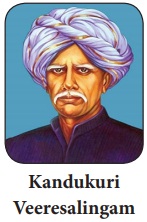Status of Women in India through the ages | Chapter 8 | History | 8th Social Science - Role of Social Reformers | 8th Social Science : History : Chapter 8 : Status of Women in India through the ages
Chapter: 8th Social Science : History : Chapter 8 : Status of Women in India through the ages
Role of Social Reformers
Role of Social Reformers
From the second half of the
nineteenth century, a number of social reformers and social reform movements
sought to promote the upliftment of women by giving them education, raising
their marriageable age and taking care of widows, as well as to remove the
rigidity of caste and raise the suppressed class to a status of equality. The
reformers who led the movements were the forerunners of modern India.
a.
Raja Rammohan Roy
There were some enlightened Indians
who supported the British attempt to reform the oppressive social order of
India. The first was the abolition of sati by law, on humanitarian grounds.
Raja Rammohan Roy, the pioneer of Indian social reform movement was a casteless
crusader of sati after having seen this practice in the case of his own
sister-in-law. He started his camping against this in human evil practice.
Influenced by the ruthless attack of the movement led by Rammohan Roy the
British government declared this act as “culpable Homicide”. Raja Rammohan Roy
is most remembered for helping Lord William Bentinck to declare the practice of
Sati a punishable offence in 1829. He also protested against the child marriage
and female infanticide. He favoured the remarriage of widows, female education
and women’s right to property. Thus the evil practice of sati on any scale was
wiped out.
b. Ishwar Chandra Vidhyasagar
Ishwar Chandra Vidhyasagar carried
on the movement for female education, widow remarriage and abolition of
polygamy in Bengal. He submitted petitions to this effect to the Indian
Legislative Council and to the passing of the Hindu Widow Remarriage Act in
1856. His son Narayanachandra set an example to others by marrying a widow of
his choice. To promote female education, Vidhyasagar founded several girls’
schools in the districts of Nadia, Midnapur, Hugli and Burdwan in Bengal.
c. Kandukuri Veeresalingam
Kandukuri Veeresalingam Pantulu was
the earliest champion in South India of women’s emancipation. He published a
journal viveka vardhani. He opened his first girls’ school in 1874 and made
widow remarriage and female education the key points of his programme for
social reform.

d. M.G. Ranade and B.M. Malabari
In Bombay presidency, M.G. Ranade
and B.M. Malabari carried on the movement for the upliftment of women. In 1869,
Ranade joined the Widow Remarriage Association and encouraged widow remarriage
and female education and opposed child marriage. In 1887, he started the
National Social Conference, which became a pre-eminent institution for social
reform. In 1884, B.M. Malabari, a journalist, started a movement for the
abolition of child marriage. He published pamphlets on this subject and
appealed to the government to take action.
e. Gopal Krishna Gokhale
In 1905, Gopal Krishna Gokhale
started the Servants of India Society which took up such social reform measures
as primary education, female education and depressed classes’ upliftment. The
spread of female education further led to the participation of women in the
freedom struggle.

f. Periyar E.V.R.
Periyar E.V.R. was one of the
greatest social reformers of Tamil Nadu. He advocated women education, widow
remarriage and inter-caste marriages and opposed child marriages.
g. Women Reformers
Most of the reform movements like
Brahma Samaj (1828), Prarthana Samaj (1867) and Arya Samaj (1875) were led by
male reformers who set the limit of the freedom and development of women. Women
reformers like Pandita Ramabai, Rukhmabai and Tarabai Shinde tried to extent
further. In 1889, Pandita Ramabai opened Sarada Sadan (Home of Learning) for
Hindu widows in Bombay. It was later shifted to Poona. Her greatest legacy was
her effort, the first in India, to educate widows. Theosophical society was
established at Chennai and Dr. Annie Besant who came from Europe and joined it.
It also developed general social reform programme.
Dr. S. Dharmambal was another
reformer who was very much influenced by the ideas of Periyar. She showed great
interest in implementing widow remarriage and women education. Among ‘Moovalur
Ramamirdham Ammaiyar’ raised her voice against Devadasi system along with Dr.
Muthulakshmi Ammaiyar. In her memory, the government of Tamil Nadu has
instituted the “Moovalur Ramamirdha Ammal Ninaivu Marriage assistance scheme”,
a social welfare scheme to provide financial assistance to poor women as
poverty was the root cause for all these evils. Thus women reformers also
contributed a lot for winning their own rights.

Leading women realized the need of
forming their own associations in order to safeguard their interests. As a
result three major national women’s organizations – Women’s India Association,
National Council of Women in India and the All India Women’s Conference were
founded.
Related Topics